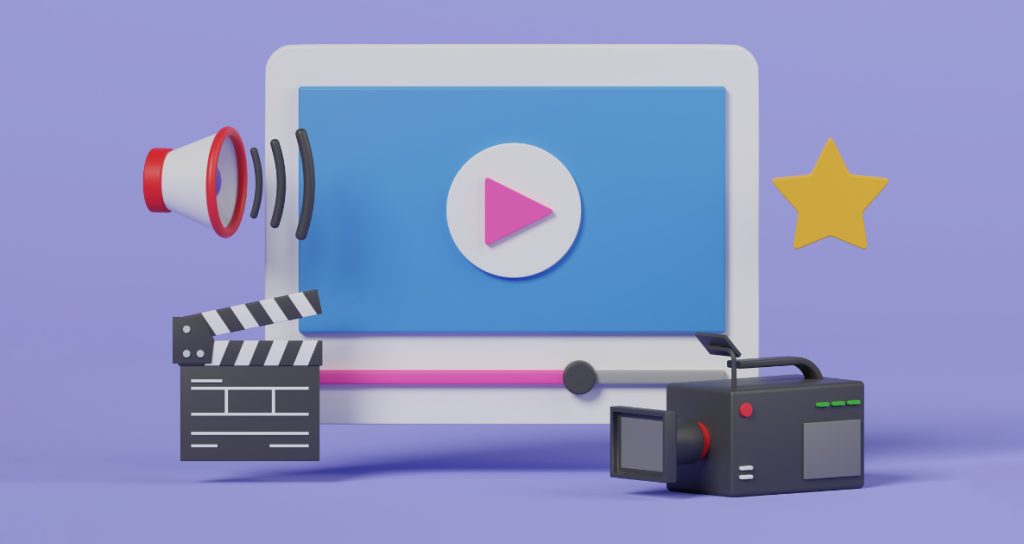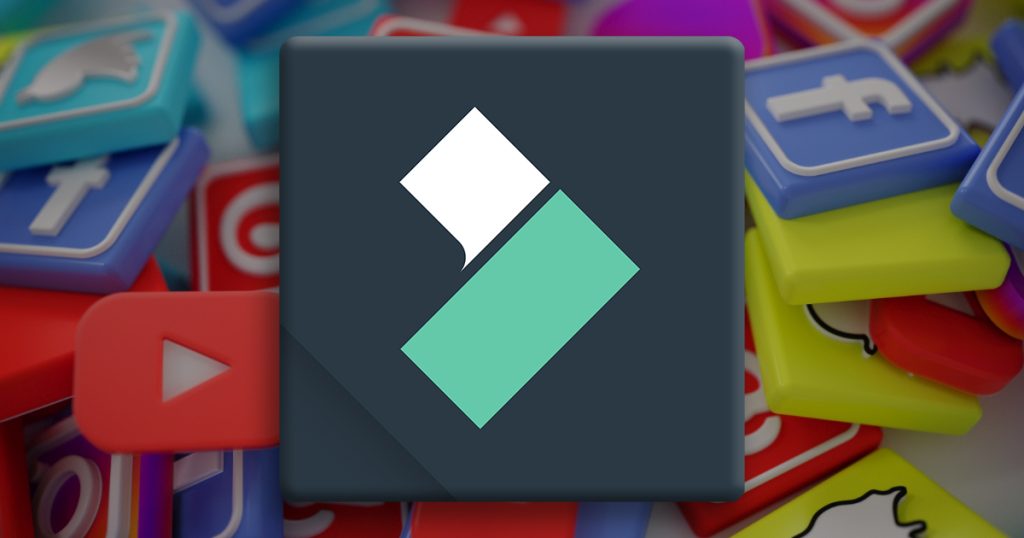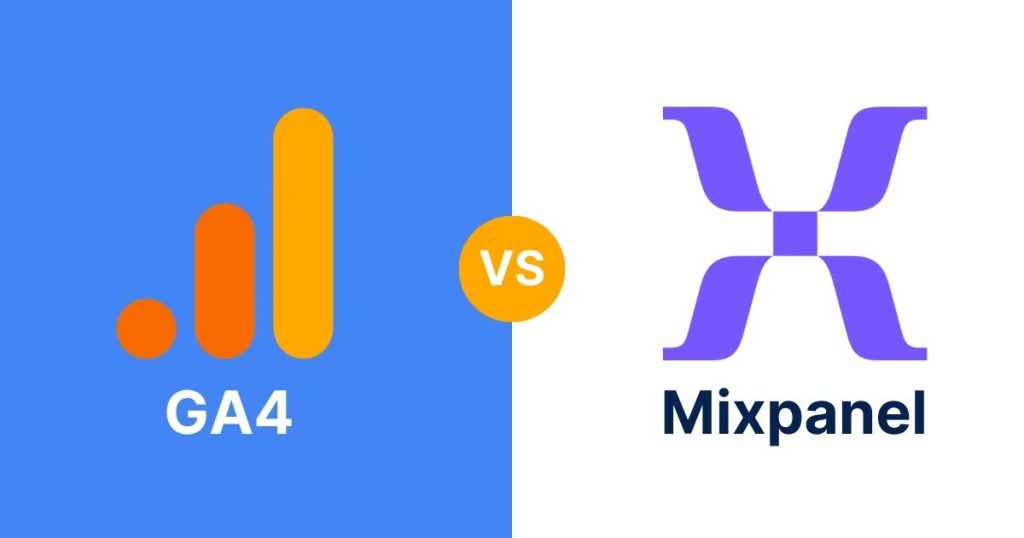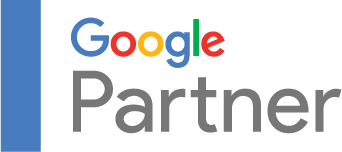What is Market Segmentation?
Market segmentation is the process of categorizing customers within a market into smaller, more homogeneous groups. Traditionally, demographics such as age, gender, and income have been commonly used for segmentation. However, alternative approaches include segmenting based on usage rates or specific product benefits. In essence, market segmentation aims to identify distinct customer groups that share similar characteristics or behaviours.
As you know, not all of your customers have the same characteristics or share the same profile which is where Market Segmentation comes in handy. Read about our top tips regarding defying your customer, building a persona and adapting your marketing strategies to well defined customer segments.
Who are You Selling To?
If I asked you: »Who is your service for?« a great many of you would be more or less vague. »Well, for anyone, really.« »You know, for people who have use for this kind of stuff.«
That won’t bring any customers. Wanna know why? Because if you have no idea who you’re selling to, you’ll have no idea how to sell it to them.
Say I want to convince my mom to switch from one smartphone brand to another. I will have to emphasize specific traits, benefits that align with her values. That same approach probably won’t work on my brother or father! Why is that? Because they have different interests. And the same principles apply in business. I might have ironclad arguments, I can be incredibly persuasive, and the product itself might be simply awesome, but some might still decide that they can live without it.
Your job is to learn how to recognize those who your product can persuade and design your communication to address their unique needs and preferences. Let’s borrow my family again (I hope they never read this).
Customer Segmentation - Let's Take the Example of my Family
So if I want to persuade my mom, I will have to play on what I know can convince her. Elegant design. Unique colors. Easy interface, intuitive UX, but she won’t meddle much with the settings, so there’s no point highlighting all the functionalities.
My dad doesn’t care about smartphones one way or the other, so no matter how I try, he will stay with his decade-old mobile phone that’s barely able to accept calls.
My brother is a whole other story. As a member of generation Z – often called digital natives – he basically grew up with technology and considers it a crucial part of his life. He wants it all: functionality, responsiveness, cool features. He’s a guy, so while he likes nice design, colors and shapes are of secondary importance to him (oh, and he is color blind). As an athlete, he needs responsiveness, excellent connectivity to other wearables, reliable support of his many sports apps – you get the point. I will have to play on those to get his attention.
Let’s make it even more complicated and add to the mix my boyfriend, a mobile app developer. He will not be fooled by fancy marketing slogans and will see right through me if I try to oversell it. Convincing him will be the hardest because he has the knowledge (more than me, obviously) and a deep understanding of the field. But if I present the correct benefits, he can become not just a one-time buyer but a long-term customer. So he’s definitely worth the effort!

By now, you must have already started furrowing your brow. »Um, is that even possible?«. Yes and no. The truth is, you will never be liked by everybody. No one can. So you have to scour the market, search the niches, interest communities to find that group (or groups) of people who will jump at the opportunity to experience what you’re offering.
When you know who they are, you get to know them – what they like and how they like to get it. Admittedly, it’s a bit easier when you’re talking about people who you’ve grown up with compared to random strangers you’re hoping will decide to become your customers.
If you know them, you know what they need. If you know what they need, you know how to present your product as a solution for that need.
Market Segmentation
What I described so eloquently with my family as an example is called market or user segmentation. Simply put, you select from the entire market the groups of people for who your product or service is the best fit.
You can consider each – my mom, my bother, and my boyfriend – as an individual segment of the market. They are all interested in my products, but with specific characteristics, pain points, and needs that I have identified. We’ve already decided that my dad is out of the equation because he is simply not the target group for my product.
When I have my groups, my target audience, I try to figure out how successfully my product addresses each of their needs and try to anticipate their objections and how to overcome them.
Feedback you may receive:
It’s too expensive. I have to up my benefits game. If I’m selling a great product or service (as are you, hopefully), there is no doubt that I can convince people that it’s worth their money.
It’s too complicated. Ok, I need to present it in a way a doctor and a high-school student can both understand. And remember what Einstein said – if you can’t explain it simply, you don’t understand it well enough.
Those are just two examples, and once you define your audience and complete customer segmentation, you will have to think long and hard about their possible objections and how to solve them. They can make or break your business!

Selling without knowing who you’re selling to is kinda similar to the promoters we see on the streets, shoving leaflets into the hands of anyone who passes them by. You might give it a glimpse, but the majority of us will just throw it away – and with it, the company’s money for design, print, and paying the poor fellow handing them out. In other words, a lot of wasted money and effort.
Knowing who you’re selling to lets you focus your time, money, and efforts on the people who are most likely to become your customers.
Trends of market segmentation in 2023
Unlock the potential of market segmentation. Stay ahead of the curve and capitalize on the latest advancements to elevate your business strategy. Here are some trends to look out for.
Increased use of AI and Analytics
Marketers are leveraging AI and analytics to make better decisions by analysing abundant data. This technology enables them to gain valuable insights into their customers’ needs, wants, and desires.
By analysing data from various sources, such as social media, website interactions, and purchase history, AI can identify patterns and trends that help create more accurate customer segments.
Real-time data analysis empowers marketers to adapt and optimize segmentation strategies in response to emerging trends. This trend enables businesses to make informed decisions and deliver tailored experiences that drive customer satisfaction and loyalty.
Enhanced focus on customer needs
This customer-centric approach allows marketers to tailor their marketing efforts more effectively, addressing the specific pain points, motivations, and preferences of different customer segments. By leveraging data analytics and customer insights, marketers can identify and target niche segments with customized messaging and offerings.
Market segmentation based on customer needs enables marketers to deliver more relevant and personalized experiences, leading to higher customer satisfaction and engagement. It also allows for the optimization of marketing resources by targeting segments that are most likely to convert and maximize ROI.
Greater emphasis on customer experience management (CEM)
Marketers are now using analytics and AI-powered tools like chatbots to understand and enhance the customer experience. This allows them to gain insights into consumer behavior and preferences, ultimately improving their marketing efforts.
By focusing on customer experience management in market segmentation, marketers can foster stronger connections with their customers. By understanding consumer behavior and preferences, they can create targeted campaigns, deliver personalized recommendations, and provide exceptional customer service.

Trends that have been prevalent in recent Years and are still in use
Micro-Segmentation
This is a further refinement of segmentation where customer groups are broken down into even smaller segments, often using machine learning and AI techniques to identify patterns and behaviors.
For example: A fashion retailer uses machine learning to analyse customers’ shopping behaviour on its website. It segments customers based on details like frequently browsed categories (e.g., casual wear, formal wear), preferred price range, preferred brands, and colour preferences. This allows the retailer to send highly personalized email campaigns, such as a discount on a customer’s favourite brand or new arrivals in their preferred category.
Predictive Segmentation
Predictive segmentation is based on predictive analytics, which uses data, statistical algorithms, and machine learning techniques to identify future outcomes based on historical data.
For example: A mobile gaming company uses predictive analytics to segment its users. By analyzing historical data, they can predict which users are likely to make in-app purchases. They can then target these users with special offers to encourage purchases. They can also predict which users are likely to stop using the app, and target these users with engagement strategies to retain them.
Customer Journey Segmentation
This is a newer form of segmentation that takes into account the different stages of the customer’s journey, from awareness to consideration to purchase and beyond.
For example: A software as a service (SaaS) company might segment customers based on their stage in the customer journey. For example, they might send educational content to customers in the “awareness” stage, free trial offers to customers in the “consideration” stage, and customer testimonials or case studies to customers in the “decision” stage.
Psychographic Segmentation
This is a more complex form of segmentation that takes into account the customer’s personality traits, values, attitudes, interests, and lifestyles.
For example: A travel company might segment its customers based on their lifestyle and interests. For instance, they might have one segment for “adventure travelers” who value experiences like hiking and skydiving, and another segment for “luxury travelers” who value comfort and luxury. They can then target each segment with tailored travel packages.
Behavioural Segmentation
Behavioral segmentation is based on customer behaviors, such as their purchasing habits, brand interactions, user status, and product or service usage.
For example: An online grocery store could segment its customers based on their purchasing habits. For example, they might have one segment for “weekly shoppers” who make large purchases once a week, and another for “daily shoppers” who make small purchases almost every day. They could then target the “weekly shoppers” with bulk discounts and the “daily shoppers” with daily deals.
Demographic Segmentation
This is the most common form of market segmentation, and it’s based on quantifiable characteristics of consumers, such as age, gender, income, education, and occupation.
For example: A cosmetic brand might have different product lines for different demographic segments. For instance, they could have a product line for teenagers that addresses common teenage skin issues like acne, and a product line for older adults that addresses common skin issues in that age group, like wrinkles and dry skin.
Geographic Segmentation
This type of segmentation divides the market based on geographic boundaries.
For example: A restaurant chain might segment its markets by city. They could offer different menu items in different cities based on local taste preferences, and run city-specific marketing campaigns. For example, they might offer spicier food options in cities where spicy food is popular.
So How do I get Started?
In this comprehensive step-by-step guide, we will explore the key stages and considerations involved in successful customer segmentation, empowering you to make informed decisions and drive meaningful results for your business.
Step 1: Preliminary Research
You’ve already sold your first batch of the product (even if those were just your friends and friends’ friends), so you already have a base of customers you can analyze. Talk to them, call them, send out simple surveys, conduct one-on-one talks.
Example of questions you might include:
– What convinced you to buy our product?
– What did you like the most about your experience with us?
– Is there anything you missed or you think we can improve?
– Why did you choose us over the competition?
The answers might surprise you and show you that your customers perceive your brand or product completely differently than you do. As you know, the Devil’s in the details, so let’s properly define those details …
Further reading: we wrote an article specifically on the topic of basic user research. Read about user-centered marketing here.
Step 2: Define the type of market segmentation
As you probably know, segmenting means grouping things together by shared commonalities. For example, you might segment animals according to what they eat into herbivores, carnivores, and omnivores (that would be us, by the way). If you change criteria and segment by where they live, you will get terrestrial animals, marine animals, and those who prefer the air. Now, terrestrial animals include all of the groups we’ve segmented according to nutritional preferences: herbivores, carnivores, and omnivores.
With this little animalistic detour I wanted to get you acquainted with the concept and importance of segmentation . Now let’s return to what you’re really interested in – segmenting your target market.
We’ll look at four basic segmentation categories: demographic, firmographic, psychographic, and behavioral. Let’s take a better look at each:
Demographic data is based on individual attributes such as gender, location, education, and income levels, etc.
Firmographic data is a classification according to the company’s attributes such as industry, size, revenues, etc.
Psychographic data includes personal criteria such as lifestyle, personality traits, values, and opinions.
Behavioral data is a classification based on how and why a customer buys a product (product usage rate, type of benefits that attract them, the occasion on which they need the product, etc.).
While the first two will be easier to define, the second two give much deeper and valuable insights. It also depends if you aim at B2C or B2B customers. Startups and smaller companies can start with the first two categories, which admittedly are broader but will nevertheless point you in the right direction.
You can already create some crude market segmentation by simply considering what you’re offering. Is your product high-end? Then you’re probably looking at people or companies with higher income. Is it a product that traditionally attracts more female or more male audience? Target those. Is it very field-specific? Perfect, the more you can narrow down your audience, the easier it is to clearly define your targets.
If you’re interested in learning more about this we wrote an article on how to build personas. Dive deeper into the tools and processes you can use to collect relevant quantitative data on your customer segment.
Step 3: Start Testing
Now that you have a battle plan, it’s time to write down the questions that will get you the answers you need. Let’s say you decided to go with a combination of demographic and psychographic data. Create a more in-depth and comprehensive survey, which will take from 5 to 10 minutes to complete.
Your survey should consist of the following questions: age, gender, household income, location (you don’t need their address, you’re more interested if they live in an urban, suburban, or rural area).
Now comes the psychographic part. You want to learn what they value, what they are prepared to pay more for. Consider dilemmas such as paying more for an environmentally friendlier product/packaging or higher quality, impulse shopping, loyalty to brands, the importance of design.
You can use Survey Monkey, Typeform, Google Forms, SurveySparrow, and many more online tools to create your survey. Let your customers rate how much they agree with each statement on a scale from 1–5 (absolutely disagree, somewhat disagree, neutral, somewhat agree, absolutely agree).
Of course, there are just a couple of examples, so adapt those to the specifics of your products.
Designing a survey takes lots of experience, but we have collected some basic do’s & don’ts in our article ‘How To Design a Survey’. Check it out to avoid the most obvious pitfalls.
Step 4: Analyse
Phew. You think getting here was hard? Now comes the herculean task: combining all those inputs, all those different people, their needs and wants into data on which you can act.
How do you do that? Find those who share common traits and putting them in the same group. Then you will see, for example, which age group, gender, income, and education level are the most represented. Those will be your foundations for building a proper tone of communication, a strong marketing strategy, and all other ingredients of a successful brand.
You can roll up your sleeves and go about it manually, reading through the responses and grouping them according to age group, gender, level of income. This works fine when your sample is small, and you’re dealing mostly with demographic and firmographic data. If you added the other two segments, you should think about a powerful analyzing tool.
But don’t get discouraged if you have a small sample, mostly consisting of demographic data. Even knowing if your customers are predominantly male or female, teenagers or middle-aged, men of women will provide a great starting point.
Keep in mind that you don’t want to have more than four segments or target groups. Choose those not only interested in your product but who can also afford it. If your product is of the highest quality and it comes with a hefty price, people who value quality but have low income will not likely convert to your customer no matter how interested they are.
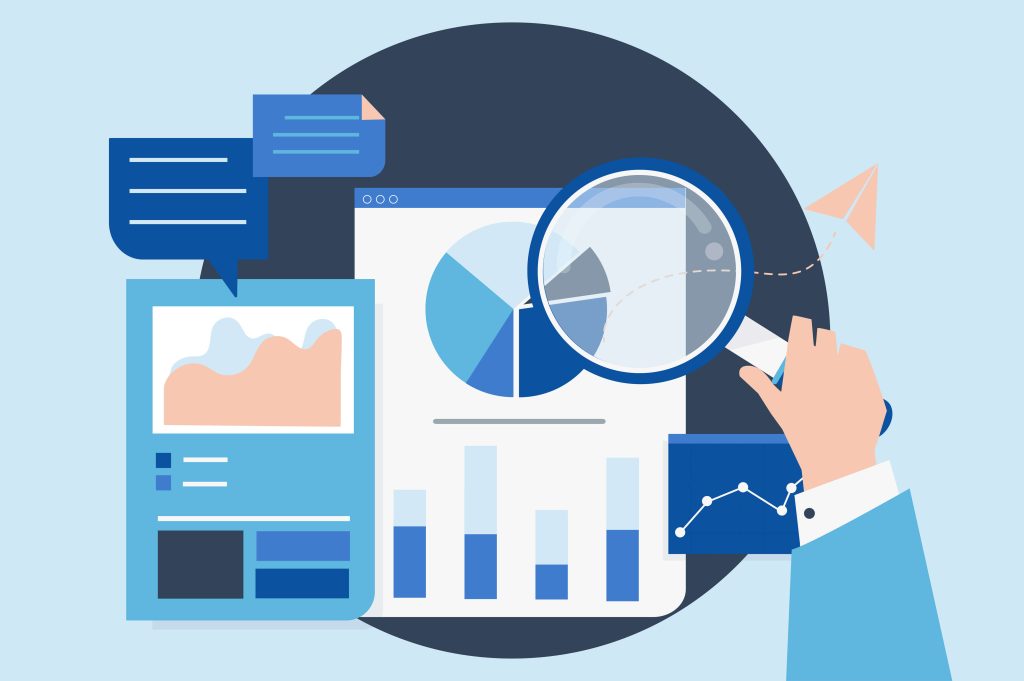
Step 5: Test and repeat
Now that you know your customers are, say, mostly men in their early thirties with slightly above-average income, living in urban areas, and rely heavily on their smartphone, it will be much easier to adapt your marketing strategy and communication, right?
To further define your audience, you can create a buyer persona for each segment you’ve specified. Complement the data you’ve already have by imagining a real person with those characteristics. Try to anticipate their pain points, how they like to be addressed, where they want to be contacted (email, newspaper ads, mobile phone), etc.
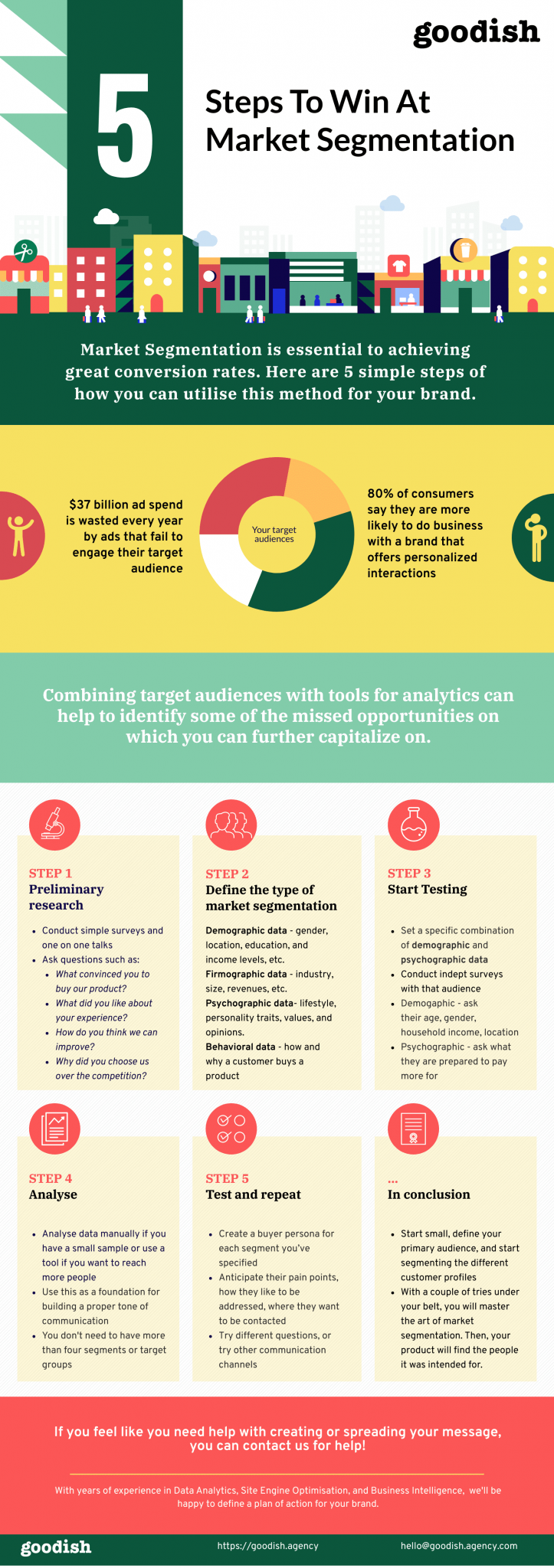
Did you like this article? Make sure to download the infographic so you can use it in the future!
Most likely, you will quickly learn that market segmentation is not an exact science, and it will take a couple of tries. Try segmenting according to behavioral instead of psychographic data. Try different questions, or try other communication channels to get enough responses to see patterns.
It might sound like a daunting task, but keep in mind that business is a long game. There are no instant results, and work is never ending. Start small, define your primary audience aka. the target market, and start segmenting the different customer profiles. With a couple of tries under your belt, you will master the art of market segmentation. Then, your product will find the people it was intended for.
Don’t worry. Incorporating this idea of constant learning based on your data can make a person dizzy at first. But once the results start multiplying, and they will, you’ll love seeing your company grow by communicating a clear message to your target market. If, however, you feel like you need help with creating or spreading your message, you can contact us for help by clicking the button below.



